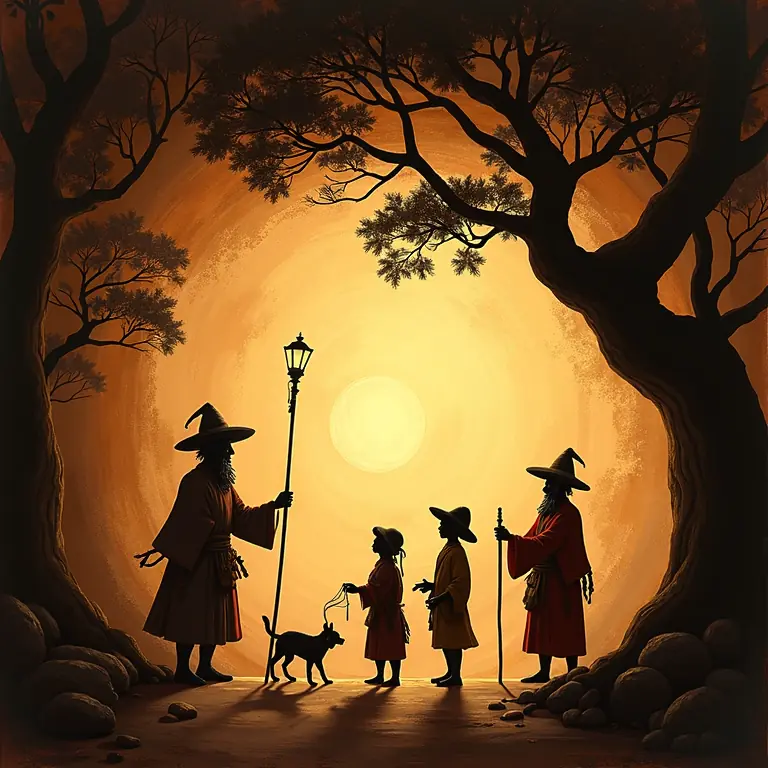Shadow puppetry. The very phrase conjures images of flickering silhouettes, enchanting stories, and a sense of ancient mystery. But beyond the magic lies a surprisingly detailed history, rich with cultural significance, intricate craftsmanship, and even a dash of scientific understanding. This article delves into the world of shadow puppetry, exploring its origins, the techniques employed, and the diverse cultural tales it has carried across continents and centuries. Prepare to be illuminated – pun intended!
The Dawn of Shadows: Origins and Early Forms
Pinpointing the exact birth of shadow puppetry is a challenge. The art form likely arose independently in various parts of the world, making a single origin story impossible. However, the earliest documented evidence points to China and India around the 2nd century BCE.
In China, the legend attributes the art’s creation to Emperor Wu of the Han dynasty (141-87 BCE). Distraught by the loss of his beloved concubine, Lady Zhao, he sought a way to see her image again. His court scholar, Lian Lü, allegedly created a shadow figure of Lady Zhao using leather and a translucent screen, bringing her ‘back to life’ through shadow. While the historical accuracy of this tale is debated, it establishes a deep connection between shadow puppetry and notions of remembrance and the spiritual world in early Chinese culture. The Chinese tradition, known as Pi Ying Xi (皮影戏, literally “leather shadow play”), quickly evolved into a sophisticated art form, incorporating elaborate puppets, painted backgrounds, and operatic singing.
Simultaneously, in India, shadow puppetry, known as Tholpavakoothu in Kerala and Chhaya Natak in northern India, was flourishing. These traditions are deeply intertwined with religious narratives, particularly the epics Ramayana and Mahabharata. The puppets were often larger and more stylized than their Chinese counterparts, and the performances were typically conducted during religious festivals. Interestingly, the Indian traditions often used a single lamp as the light source, creating a more dramatic and focused shadow effect.
Evidence suggests that shadow puppetry also existed in ancient Greece and Rome. While less documented than its Asian counterparts, literary references and archaeological findings indicate the use of shadow figures for entertainment and storytelling. Some scholars believe the practice spread eastward from these regions, influencing the development of shadow puppetry in Asia, but the direction of influence remains a subject of ongoing research.
The Mechanics of Magic: Puppetry Techniques
The fundamental principle of shadow puppetry is remarkably simple: an opaque object is placed between a light source and a translucent screen, casting a shadow that forms the visual element of the performance. However, the execution of this principle requires considerable skill and artistry.
Puppet Construction: Traditionally, puppets were crafted from translucent materials like leather (often water buffalo hide in Asia), paper, or even thin wood. The leather was meticulously carved, painted, and often perforated to create intricate designs and allow light to pass through. The complexity of the puppet’s design directly impacts the detail of its shadow. Modern shadow puppetry utilizes a wider range of materials, including plastic, cardboard, and even metal, depending on the desired aesthetic and durability.
Articulation and Manipulation: Puppets aren’t simply flat shapes. They’re articulated, allowing for movement and expression. Traditionally, this articulation was achieved through a system of rods attached to various parts of the puppet – the head, arms, legs, and sometimes even the fingers. The puppeteer manipulates these rods to bring the puppet to life, creating a fluid and expressive performance. Different regions developed unique methods of articulation. For example, Javanese Wayang Kulit puppets often have incredibly intricate arm and leg movements, achieved through a complex system of rods and hinges.
The Screen (and Beyond): The screen itself is crucial. Traditionally, it was made of stretched, translucent cloth, often white cotton or silk. The material’s opacity affects the shadow’s clarity and brightness. The distance between the puppets, the light source, and the screen also plays a significant role in the size and sharpness of the shadows. Modern performances sometimes use more sophisticated screens, including translucent acrylic or even projected surfaces.

Light and Shadow Play: The light source is the heart of the performance. Traditionally, oil lamps or candles were used, creating a warm, flickering light that added to the atmosphere. The movement of the flame also caused the shadows to dance and shimmer, enhancing the sense of magic. Modern performances often utilize electric lamps, allowing for greater control over the intensity and color of the light. The skillful manipulation of light and shadow is key to creating depth, texture, and emotional impact.
Cultural Tapestries: Shadow Puppetry Around the World
Shadow puppetry isn’t confined to China and India. It has taken root and flourished in diverse cultures across the globe, each developing its unique style and repertoire.
Southeast Asia: A Rich Tradition
Southeast Asia boasts a particularly rich tradition of shadow puppetry. In Indonesia, Wayang Kulit is a highly respected art form, deeply embedded in Javanese and Balinese culture. Performances often last for entire nights, narrating episodes from the Ramayana and Mahabharata, accompanied by a gamelan orchestra. The puppets themselves are considered sacred objects, imbued with spiritual power.
In Cambodia, Sbek Thom features large, imposing leather puppets used to depict scenes from the Reamker (the Cambodian version of the Ramayana). These performances are often associated with royal ceremonies and are considered a national treasure. Malaysia also has its own unique forms of shadow puppetry, such as Wayang Kulit Kelantan, which features distinct puppet designs and storytelling traditions.
Turkey: Karagöz and Hacivat
Turkish shadow puppetry, known as Karagöz and Hacivat, is characterized by its comedic and satirical nature. The two main characters, Karagöz (a common man) and Hacivat (a more educated and refined figure), engage in witty dialogues and playful banter, often poking fun at social and political issues. The performances are traditionally performed behind a translucent screen, with the puppeteer providing the voices for both characters. This tradition is closely linked to the coffeehouse culture of Turkey, where performances were often enjoyed alongside coffee and conversation.
Egypt: A Revival of an Ancient Art
While less widely known today, Egypt has a long history of shadow puppetry dating back to the Ptolemaic period. In recent years, there has been a revival of interest in this ancient art form, with artists experimenting with new techniques and incorporating contemporary themes. The Egyptian tradition often features puppets representing everyday people and animals, and the stories tend to be more lighthearted and humorous than those found in other cultures.
Beyond: Exploring Global Variations
Shadow puppetry can also be found in Greece (where it’s known as Karagiozis), Syria, and even parts of Europe. Each region has adapted the art form to its own cultural context, resulting in a fascinating array of styles and traditions.
The Science of Illusion: Perception and Psychology
Beyond the artistic and cultural aspects, shadow puppetry offers a fascinating glimpse into the science of perception. The art form relies on our brains’ ability to interpret incomplete information and create a coherent visual experience. The shadows themselves are merely two-dimensional projections, yet we perceive them as three-dimensional objects with depth and form.

This phenomenon is related to the principles of Gestalt psychology, which emphasizes the brain’s tendency to organize sensory information into meaningful patterns. Our brains fill in the gaps in the shadow, creating a complete image based on our prior experiences and expectations. The flickering light and the movement of the puppets further enhance the illusion, captivating our attention and drawing us into the story. It’s not dissimilar to the techniques used in early animation and illusionary art. For a deeper dive into how humans are tricked by perception, you might find the science behind fortune-telling methods interesting.
Shadows and Storytelling: The Power of Narrative
At its core, shadow puppetry is a powerful storytelling medium. The simplicity of the visual elements forces the audience to engage their imagination, actively participating in the creation of the narrative. The shadows become vessels for emotions, characters, and ideas.
Traditionally, shadow puppetry was used to convey religious teachings, moral lessons, and historical events. However, it also served as a form of entertainment, offering a much-needed escape from the hardships of everyday life. The stories often reflected the values and beliefs of the community, reinforcing social norms and cultural identity. The narratives themselves are often incredibly complex, reflecting the rich storytelling traditions of the regions where they originated.
The use of music and voice is also integral to the storytelling experience. The puppeteer often provides the voices for all the characters, using different tones and inflections to create distinct personalities. The accompanying music sets the mood and enhances the emotional impact of the story. The rhythmic patterns in traditional music often mirror the movements of the puppets, creating a harmonious and immersive experience. You can find similar rhythmic consistencies when studying folk music scales across cultures.
Modern Shadows: Preservation and Innovation
In the 21st century, shadow puppetry faces the challenge of preserving its traditions while adapting to a changing world. Many artists are working to revitalize the art form, experimenting with new techniques and incorporating contemporary themes.
Digital technology has also opened up new possibilities for shadow puppetry. Computer animation and projection mapping can be used to create stunning visual effects, while interactive installations allow audiences to participate in the storytelling process. However, many purists argue that the true essence of shadow puppetry lies in its handcrafted nature and the direct connection between the puppeteer and the audience.
The intricate craftsmanship involved in creating traditional puppets is a skill that is slowly being lost. There’s a growing movement to document and preserve these techniques, ensuring that future generations can continue to appreciate the artistry of shadow puppetry. The attention to detail and historical significance of the tools used to create these puppets is similar to the world of antique keys and locks.
The Enduring Appeal: Why Shadows Still Captivate
Despite the rise of new entertainment technologies, shadow puppetry continues to captivate audiences around the world. Its enduring appeal lies in its simplicity, its artistry, and its ability to transport us to another world. The flickering shadows, the enchanting stories, and the skillful manipulation of light and form create a unique and unforgettable experience.
Shadow puppetry is more than just entertainment; it’s a cultural treasure, a historical record, and a testament to the power of human imagination. It reminds us that even in the darkest of shadows, there is always light, beauty, and the possibility of storytelling. The art of crafting a compelling narrative, even in a simple form, is a universal skill, much like the elements that make a good joke.
The history of shadow puppetry also mirrors the evolution of other seemingly simple technologies, like paper money, demonstrating how traditional arts can adapt and endure through time.


 The Surprisingly Consistent Symbolism of Antique Fans – Language, Status & Victorian Courtship
The Surprisingly Consistent Symbolism of Antique Fans – Language, Status & Victorian Courtship  The Surprisingly Consistent Science of Vintage Board Game Packaging – Art, Marketing & Cultural Reflection
The Surprisingly Consistent Science of Vintage Board Game Packaging – Art, Marketing & Cultural Reflection